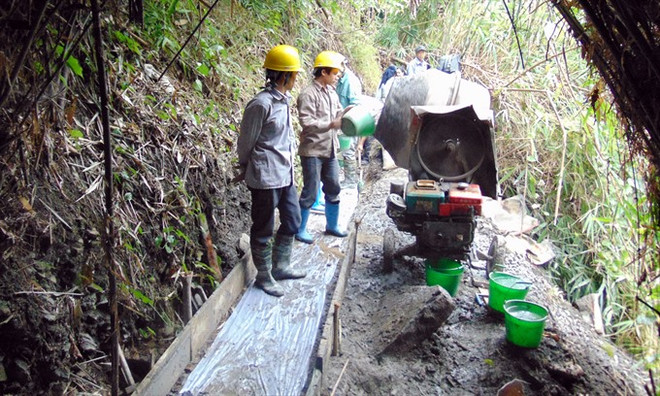 Workers on an irrigation project in Cao Tan Commune in the northern mountainous province of Bac Kan. — (Photo: backan.gov.vn)
Workers on an irrigation project in Cao Tan Commune in the northern mountainous province of Bac Kan. — (Photo: backan.gov.vn)Quang Ninh (VNS/VNA) - More than 9,100 infrastructure projects havebeen built and nearly 3,300 others have been maintained in some of thecountries most disadvantaged communes over the past three years thanks toProgramme 135.
The projects involving transport, irrigation, schools, healthcare centres,water supply, power and other fields have helped improve the living standardsand production of ethnic minority people living in the most disadvantaged areasof Vietnam.
Programme 135 - Programme for Socio-economic Development inSpecially-disadvantaged Communes in Ethnic Minority and Mountainous Areas - waslaunched 20 years ago by the government.
The programme is in its third phase from 2016 to 2020, with 2,139 communes in46 provinces across the country benefiting.
Programme 135 has been part of a major poverty reduction drive in Vietnam thathas received priority and support from the government, development partners andinternational organisations.
In 2016, Programme 135 was included in the national target efforts forsustainable poverty reduction during 2016-2020.
According to the Committee for Ethnic Minority Affairs (CEMA), in the lastthree years, as much as 19.226 trillion VND (830 million USD) from the nationalbudget was allocated for Programme 135, of which nearly 11.5 trillion VND (495.5million USD) had been disbursed.
Quang Ninh, Khanh Hoa, Vinh Phuc, Dong Nai, Can Tho and Ba Ria – Vung Tau didnot need funding from the national budget to cover their implementation ofProgramme 135. Instead, they spent about 959 billion VND from their localbudgets.
Programme 135 has also received 10 million euros from Ireland as a part of anon-refundable grant to improve infrastructure in specially disadvantagedcommunes in nine provinces, as well as other technical and financial supportfrom international organisations like the World Bank and CARE International.
Programme 135 also offers support to develop production, diversify livelihoodsand expand poverty reduction models among ethnic minority people.
The programme has also helped to improvethe capacity of people and commune officials in planning, project managementand project implementation.
Deputy Minister and vice chairman of CEMA Le Son Hai said that investment inmountainous areas which were home to ethnic minority groups meant investmentfor development.
Ethnic minority groups deserved more support and investment to catch up withdevelopment.
He said that the government had decentralised and empowered local departmentsto assess, approve and implement projects so they could be carried out morequickly.
Nguyen Thanh Nhan, policy advocacy advisor of CARE International in Vietnam,said without changes to assist ethnic minority groups, they would remained thepoorest in the country.
Nhan applaunded Government Decision 161/2016/ND-CP issued two years ago whichallows small projects to enjoy special investment mechanisms that simplifyinvestment procedures. Local People’s Committees take the role of projectinvestors while the community develops and cares for the projects using boththe State budge and people’s contributions.
Many infrastructure projects in specially disadvantaged communes were eligiblefor the mechanism that could cut costs by 20-30 percent, Nhan said, citing theresults of a study conducted by an independent consulting company.
The study also showed that decentralisation could be seen in most provinces butcommunes faced difficulties fulfilling the role of project investors andensuring the participation of local residents.
By the end of last year, people from ethnic minority groups accounted for 14.3 percentof Vietnam’s total population, while poor households from ethnic minoritygroups accounted for 52.66 percent, according to CEMA’s statistics. One inevery three people from ethic minority groups was living under the povertyline. – VNS/VNA




























